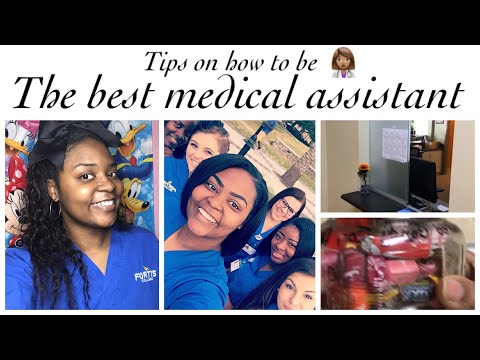How Much Schooling Does a Medical Assistant Need?
Contents
- What is a medical assistant?
- What are the duties of a medical assistant?
- What are the educational requirements for a medical assistant?
- What are the skills required for a medical assistant?
- What are the job outlook and salary for a medical assistant?
- What are the career options for a medical assistant?
- What are the benefits of becoming a medical assistant?
- What are the challenges of being a medical assistant?
- How can I become a medical assistant?
- What should I consider before becoming a medical assistant?
You may be wondering how much schooling a medical assistant needs. The answer may surprise you – it depends on the type of medical assistant program you choose!
Checkout this video:
What is a medical assistant?
A medical assistant is a person who has been trained to provide support to physicians and other medical professionals. Medical assistants perform a variety of tasks, including taking medical histories, scheduling appointments, drawing blood, and helping patients understand their medical Care.
What are the duties of a medical assistant?
Medical Assistants are unlicensed multi-skilled health professionals who perform administrative and clinical tasks in ambulatory care settings. Most of their work day is spent performing clerical duties such as answering telephones, taking medical histories, scheduling appointments, filing insurance forms, and transcribing doctors’ orders. They also perform basic laboratory tests, dispose of contaminated supplies, sterilize medical instruments, prepare patients for examination, and assist the physician during the examination.
What are the educational requirements for a medical assistant?
There are many schools that offer medical assisting programs, and the educational requirements vary by state. In general, most medical assistants have at least a high school diploma or equivalent, although some jobs may require postsecondary education, such as a certificate or an associate degree from an accredited institution.
Some employers may prefer to hire medical assistants who have completed a formal training program, which typically lasts about one year. Medical assistants who have earned certification through organizations such as the American Association of Medical Assistants or the National Healthcare Association may also have an advantage in the job market.
Many medical assistants complete on-the-job training, which typically lasts about four to eight weeks. During this time, they learn about the duties of the position and how to perform them properly.
What are the skills required for a medical assistant?
Medical assistants perform a variety of tasks in doctors’ offices and medical clinics. They might take medical histories and record vital signs, explain medical procedures to patients, prepare patients for examination, sterilize medical instruments, and schedule appointments.
Most medical assistants have postsecondary education such as a certificate. Some states have regulations regarding certification or licensure for medical assistants.
Employers generally prefer to hire candidates who have completed a postsecondary education program in medical assisting. These programs are typically offered at community colleges, technical schools, and vocational schools. Programs typically last 1 year and award a certificate or diploma upon completion. Some programs last 2 years and award an associate’s degree.
What are the job outlook and salary for a medical assistant?
Medical assistants are in high demand and the job outlook is excellent. Salary is determined by experience, education, geographic location, and other factors. Most medical assistants have at least a high school diploma or equivalent, although some positions may require postsecondary education, such as a certificate or associate degree from an accredited medical assisting program.
What are the career options for a medical assistant?
There are several career options for medical assistants. The most common is working in a physician’s office, but there are also positions available in clinics, hospitals and other healthcare facilities. Many medical assistants work full time, but there are also part-time and job-share positions available. Medical assistants typically work Monday through Friday during regular business hours, but some positions may require evening or weekend hours.
The duties of a medical assistant vary depending on the type of position and the size of the facility where they work. Typically, medical assistants perform both administrative and clinical tasks. Administrative tasks may include answering phones, scheduling appointments, verifying insurance coverage and coding medical records Clinical tasks may include taking patient histories, performing basic laboratory tests, administering injections and assisting with examinations. In some states, medical assistants may also be allowed to perform additional tasks, such as removing stitches or applying topical medications.
What are the benefits of becoming a medical assistant?
There are many benefits to becoming a medical assistant. Medical assistants are in high demand, and the job outlook is very positive. Medical assistants are able to work in a variety of settings, including hospitals, clinics, and doctor’s offices. They can also choose to specialize in a certain area of medicine, such as pediatrics or geriatrics.
Medical assistants receive on-the-job training, which means they do not need to complete a formal education program. However, many medical assistants choose to do so in order to receive more comprehensive training and be more competitive in the job market. Most medical assistant programs take about one year to complete and result in a certificate or diploma. Some programs may also offer an associate’s degree.
What are the challenges of being a medical assistant?
As a medical assistant, you will be responsible for performing a variety of tasks in a medical office or clinic. Your duties will vary depending on the size and type of facility in which you work, but may include taking and recording patients’ medical histories and vital signs, preparing patients for examinations, assisting the physician during examinations, scheduling appointments, and handling billing and insurance paperwork.
Medical assistants must be able to work well under pressure, as they often have to juggle many tasks at once. They must also be able to deal effectively with a variety of people, including patients who may be anxious or impatient.
How can I become a medical assistant?
Medical assistants perform a variety of clinical and administrative tasks to support the work of physicians and other health care professionals. They are often the first point of contact with patients and play a key role inpatient care and customer satisfaction.
Most medical assistants have completed postsecondary education, although some have earned a high school diploma or equivalent and received on-the-job training. Although not required, certification can demonstrate competence and may lead to career advancement.
Medical assistants typically complete a postsecondary education program of 1 to 2 years duration. These programs are available from community colleges, technical schools, vocational schools, universities, and online schools. A small number of high school students may learn through cooperative education programs that combine classroom instruction with paid work in medical offices.
What should I consider before becoming a medical assistant?
Before considering a career as a medical assistant, there are a few things you should take into account. First and foremost, medical assistants must be able to handle a wide variety of tasks. They may be responsible for taking patients’ vital signs, documenting medical histories, scheduling appointments, handling billing and insurance claims, or giving injections. In addition, medical assistants must be able to effectively communicate with patients, doctors, and other members of the healthcare team.
Medical assistants typically need to have at least a high school diploma or equivalent, although some employers may prefer candidates who have completed an accredited medical assistant program. Most medical assistant programs take about one year to complete and include both classroom and clinical instruction. After completing a medical assistant program, you will likely need to obtain certification from an accredited professional organization such as the American Association of Medical Assistants (AAMA).







